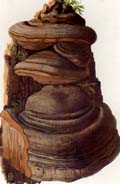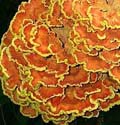Laetiporus sulphureus
 Key to Gilled Mushrooms Key
Key to Gilled Mushrooms KeyThis is a key to gilled mushrooms, that is, mushrooms having a definite cap with a fertile surface consisting of gills. The fruiting body usually also has a stem, although that may be lateral or absent (usually, then, the mushroom is growing from wood). You can use this key to identify mushrooms that you find.
 Polyporaceae Family
Polyporaceae FamilyFertile surface usually a layer of vertical tubes, of which the mouths are visible as pores on the underside of the cap or shelf.
Fruiting bodies usually tougher or harder than the "normal" gilled mushrooms, being leathery, corky, or woody. But they can be quite tender while actively growing
Once grown, they do not decay easily, remaining on the substrate for months or years
They often grow on wood, although a few are terrestrial (even those are usually growing on buried wood)
Fruiting body is usually a flat shelf, or hoof-shaped, protruding directly from the substrate, although sometimes it may have a short stalk.
Some forms never grow away from the substrate at all, so that all that is visible of the fruiting body are the pores.
Sometimes the pores are so minute that the fertile surface seems solid, until you look closely
 Lignicopolypore Subfamily
Lignicopolypore SubfamilyGrowing on wood
Sessiloporus TribeNot fitting the other choices, not stipitate
In making choices below based on texture and size, place the emphasis on texture: if left alone, some of the smaller ones can eventually get quite big; and even the huge ones have to start out small at first
 Medium Sessilopolypore Subtribe
Medium Sessilopolypore SubtribeFruiting body medium-sized, soft; shelving, often hairy or velvety when young, becoming smooth in age, often imbricate or compound
Brownish or bright yellow cap surface with (when young) whitish pores
Usually exuding liquid when squeezed or cut; often beaded with droplets on its own
 Laetiporus Genus
Laetiporus Genus
Pore surface white or bright yellow
Cap surface somewhat furry when young; usually bright yellow or orange, but may be a pink or brownish plum color
Here are the characters that distinguish this species from the others in its group. For its more general characters, see higher up on the page.
If there's just a few words or a microscopic feature here, a more thorough description can be found above.

Diagnosis
- Pore surface bright yellow; cap surface bright traffic-cone orange
-
Sessile shelves on hardwoods, especially oaks, up off the ground
Comments
A wonderful edible. I sear the shelves on both sides in a pan, blackening them a little, then add 1/4" of water, cover the pan, and steam them for a quarter hour or so. You get a nice, soft, juicy chicken experience
You have to make sure to take only pieces that are soft enough to cut easily with a knife; the older ones are not only tougher, but the flavor isn't as good. (though maybe that's partially through confusion with Laetiporus cincinnatus (see notes on that species) Anyway, it's standard practice with this species to harvest only the soft edges of the fruiting bodies, leaving the tougher centers behind. Of course, if they're new enough that the whole thing is soft, then you can take the whole thing
This fungus sometimes appears in a huge solid mass; then the entire fruiting body is soft and choice






 Key to Gilled Mushrooms Key
Key to Gilled Mushrooms Key Polyporaceae Family
Polyporaceae Family Medium Sessilopolypore Subtribe
Medium Sessilopolypore Subtribe Laetiporus Genus
Laetiporus Genus






